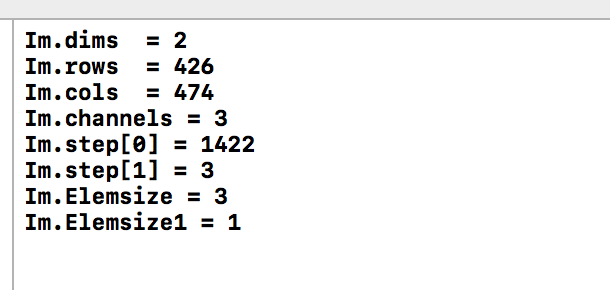OpenCV-Mat方式的獲取圖片的畫素(一)
阿新 • • 發佈:2019-01-23
作為OpenCV基礎知識中的重中之重,畫素值的讀寫需要我們很用心的掌握。
1、讀取原圖
const char filename[] = "/Users/linwang/Desktop/Lena.png"; Mat Im = imread(filename); cout<<"Im.dims = "<<Im.dims<<endl; cout<<"Im.rows = "<<Im.rows<<endl; cout<<"Im.cols = "<<Im.cols<<endl; cout<<"Im.channels = "<<Im.channels()<<endl; cout<<"Im.step[0] = " <<Im.step[0]<<endl; cout<<"Im.step[1] = " <<Im.step[1]<<endl; cout<<"Im.Elemsize = "<<Im.elemSize()<<endl; //一個畫素點的大小 CV_8U3C=1*3 cout<<"Im.Elemsize1 = "<<Im.elemSize1()<<endl; //資料型別的大小 UCHAR = 1 (ElemSize / Channel) namedWindow("Old-Lena"); imshow("Old-Lena", Im);

2、最樸素的指標偏移,讀取畫素點值,修改Lena
/*2.採用最樸素的方式修改Lena,獲得Test*/ Mat test_im = Im.clone(); for (int i = 0; i<test_im.rows; i++) { uchar * ptr = test_im.data + i * test_im.step; //step 是一行的資料長度 for(int j = 0;j<test_im.step;j++) { *(ptr + j) = i%255; //Bule } } cvNamedWindow("Test-Lena"); imshow("Test-Lena", copy_im);
3、採用C++的Vec來讀取畫素點資料
/*1.採用C++模版 STL的方式 修改Lena原圖,得到New*/ Mat copy_im = Im.clone(); for (int i = 0; i<copy_im.rows; i++) { for(int j = 0;j<copy_im.cols;j++) { Vec3b pixel; pixel[0] = i%255; //Blue pixel[1] = j%255; //Green pixel[2] = 0; //Red copy_im.at<Vec3b>(i,j) = pixel; } } cvNamedWindow("New-Lena"); imshow("New-Lena", copy_im);

4、迭代器方式遍歷影象
/*3.迭代器方法遍歷影象畫素*/
Mat IterIm = Im.clone();
MatIterator_<Vec3b> IterBegin,IterEnd; //迭代器
for(IterBegin = IterIm.begin<Vec3b>(),IterEnd = IterIm.end<Vec3b>();IterBegin!=IterEnd;++IterBegin)
{
(*IterBegin)[0] = rand()%255;
(*IterBegin)[1] = rand()%255;
(*IterBegin)[2] = rand()%255;
}
cvNamedWindow("IterImg");
imshow("IterImg", IterIm);
cvWaitKey(0);

